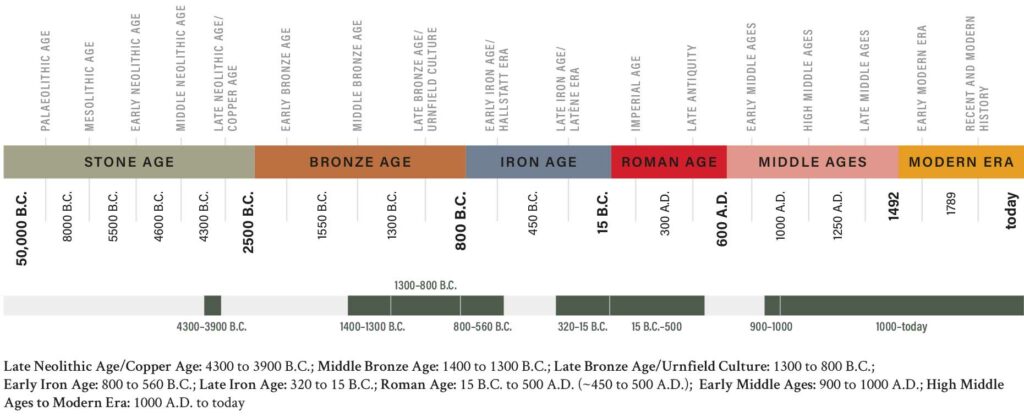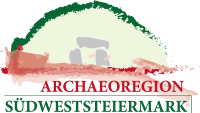Tracing back in history, one reaches the Neolithic Age (the time of the first sedentary farmers, about the 4th millennium B.C.), from which finds are available on the Frauenberg. There are remains of Frauenberg settlements also from the Copper Age and the following Bronze Age. At the end of the Urnfield period (around 800 B.C.), various large central places emerged – the well-fortified hilltop settlements indicate that it was a time of warlike conflicts. In the Iron Age, a powerful center formed in western Styria, on the Burgstallkogel near Grossklein, which is considered a princely seat and probably held supraregional importance. At this time (around 600 B.C.) there was also a settlement on the Frauenberg, of which graves in Leibnitz-Altenmarkt but also on the Frauenberg itself bear witness.
The settlement probably became a central site in the time of the Celts (about 450 – 15 B.C.) when individual tribes we cannot name with certainty, advanced into the southern Styrian region. At the end of this Celtic period (the so-called Latène period) the first written testimonies appear and also an coinage has been documented for the Frauenberg in this period.
In the last 30 years, numerous areas of this site, sometimes referred to as “oppidum,” have been investigated archaeologically. In addition to excavations by the Landesmuseum Joanneum, investigations by the Federal Office for the Protection of Monuments and by the Austrian Archaeological Institute have contributed to its exploration. Spectacular were the emergency excavations on the so-called “Perl-/Stadläcker” fields, a lower terrace at 350 m on the eastern slope of the settlement. A Celtic sanctuary could be partially uncovered and investigated, consisting of a ditch measuring about 90 by 60 m and about 5 m wide, an inner wooden palisade and various other wooden structures.
We get a vague idea about the cult activity from findings in other places as well as from the find material itself: In the context of large cultic gatherings, countless cattle were sacrificed and individual parts – interestingly, almost exclusively the shoulder bones – were deposited in the ditches. Coins, costume parts and weapons, which had previously been deliberately bent and thus rendered useless, were also sacrificed in the ditch. The importance of the sanctuary is shown by the amount of cattle that were sacrificed here: Thousands of cows can be inferred from the bones alone which were found during the excavation that, however, only covered a fraction of the entire complex. At the center there may have been the worship of a deity thought to be present in some form at this site where an ancient Hallstatt burial mound was visible. Cultic activities probably took place until the early Roman Imperial period, but they ceased at the latest under the emperor Claudius, who forbade bloody sacrifices by the druids (41-54 A.D.).
From the Roman Imperial period we know of a sanctuary in a central location on the Frauenberg (fig. 2). Its exploration began in the 1950s, when the substructure of a comparatively well-preserved temple was uncovered. In the last ten years, the somewhat higher area to the west of this structure was explored and valuable findings were documented. These date back to the Celtic Latène period, but differ significantly from the previously described traces of a cult site. Post pits, which can be regarded as remains of a wooden building, and other smaller pits contained find material, of which the many amphora fragments are the most interesting. They show that wine was brought here from Italy already in the late Celtic period in the 1st century B.C. It was probably consumed here, and the amphorae were subsequently smashed, leaving only small fragments of the large transport vessels. This process of smashing can be connected with cult practices, as they are sometimes attested in Late Celtic contexts. In the lower cult area mentioned above, feasts were also held, wine was consumed and libations were offered, but the bloody sacrifices, to which the animal bones testify and which can be connected with the work of the druids, gradually receded into the background until they were forbidden in the Imperial period.
The first stone building (fig. 2, red) in the temple district dates from the middle of the 1st century A.D. It is a simple quadrangular structure which was surrounded by a larger enclosure a quarter of a century later. The reconstruction of this already monumental structure has not yet been clarified. Apparently, the cult building was already oriented to the east and towards an altar which stood in an axial relation and was connected to the temple by a wide flight of steps. When the large podium temple (fig. 2, dark blue) was built in the Late Flavian or Trajanic period, it was moved so far to the northeast in the sloping terrain that the older altar could keep its place. The entrance to the temple was not a wide flight of steps, as was common in comparable buildings, but two narrow stairs in between which there was enough space for the older altar.
The design of the area south of the podium temple is unclear. However, it is very likely that there were further secondary buildings like smaller chapels or halls. Among the gods worshipped in the Roman sanctuary, the nursing goddesses (fig. 3) are probably among the most important. They may have been invoked as emergency helpers and protectors of infants. Numerous statuettes have been found in the sanctuary showing the seated goddesses holding in their laps and nursing a swaddling baby.
In the past, the podium temple was considered to be a temple of Isis, and the alignment of Isis with the goddess Noreia, known in inscriptions from Carinthia, was also considered for this place of worship. In the colonia Claudia Savaria, today’s Szombathely, which adjoined the city territory to the east, Isis was also among the prominent deities, which is why her worship was also assumed on the Frauenberg.
A marble statue (fig. 4) as well as an altar for the god Mercury, donated by a member of the upper class of Flavia Solva, prove that this god also was held in high esteem in the sanctuary. There is also evidence in inscriptions of the gods Mars Latobius (who was invoked in an inscription with the Celtic names Marmogius, Sinatis and Toutatis) and the horse goddess Epona.
The importance of the Frauenberg sanctuary for the municipium Flavia Solva is unfortunately still too little known, but it can be assumed that it played a central role for the city. The purpose of sanctuaries as identity-forming places, where myths fundamental to the community were handed down and cultivated at annually repeated festivals, has been sufficiently studied for Roman cities. In places of the Gallo-Roman provinces, where Celtic traditions were strong, the sanctuaries were often the seat of the former civitates which held their meetings there. For the Frauenberg a comparable function is not documented but can be assumed by comparing it to other cult places. The regular expressions of loyalty to the Roman imperial house also took place at these sites, which is why celebrations in connection with the imperial cult are conceivable for the Frauenberg. When in the middle and later imperial period (in the 3rd and 4th centuries A.D.) the political and economic conditions changed and under the pressure of Germanic tribes the border defense had to be reorganized, the Frauenberg received a new significance.
The Frauenberg, which was much easier to defend, became a fortified settlement again, whereas Flavia Solva, which was situated in the plain and had no city walls, was abandoned. A smaller military unit that secured this retreat settlement is now believed by most archaeologists to have been located on the mountain. The fourth century was also the time when Christianity became the official religion and – after a period of co-existence with pagan cults – the older cults were completely banned at the time of Emperor Theodosius. It will not have taken long until this new state religion replaced the older cults at the summit of the Frauenberg. The place of worship was thus retained and a first church was built over the old sanctuary. Neither the chronology nor the ground plan of this church complex are clear yet, but the most likely assumption is that of an early rectangular church over the vestibule of the podium temple, which was later successively expanded into a larger church complex with a baptistery in the west. In any case, the numerous marble fragments of interior furnishings, a choir screen, possibly an anvil or ciborium, and refectory slabs found during the excavation indicate that a substantial church was located here in the fifth century, which could have been the seat of a bishop.
The early Middle Ages are still comparatively little researched for our area. It is questionable whether a continuity from Late Antiquity to the Middle Ages and thus to our time can be traced, as one might assume, or whether the historically documented expansion of the Avars and the Slavs destroyed the Frauenberg settlement. However, grave finds from the temple district point to a church of early medieval times; the church that exists today was first mentioned in documents as “ecclesia Sanctae Mariae in monte” in 1107. As a branch church of the parish of Leibnitz in the Marian pilgrimage site of Frauenberg, it is still of great importance today.
Many new archaeological discoveries in recent years have clarified the picture of the sanctuaries on Frauenberg. In addition to the excavation findings, our knowledge can be expanded and the connection of the sanctuary to the city in the plain can be more closely illuminated by analyses of find material, by comparative consideration of findings from different geographical areas and by the attempt of a synopsis of different source genres. Let’s hope that we will succeed in doing so.


